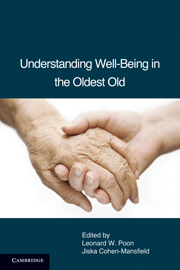Book contents
- Frontmatter
- Contents
- List of Tables
- List of Contributors
- Foreword by Carol D. Ryff
- PART I THEORY: NEW HORIZONS IN WELL-BEING RESEARCH
- 1 Toward New Directions in the Study of Well-Being among the Oldest Old
- 2 From Ageless Self to Selfless Age: Toward a Theoretical Turn in Gerontological Understanding
- 3 The Pursuit of Happiness: Alternative Conceptions of Subjective Well-Being
- 4 The Shifting Baseline Theory of Well-Being: Lessons from across the Aging Spectrum
- 5 The Model of Developmental Adaptation: Implications for Understanding Well-Being in Old-Old Age
- PART II PARADISE LOST: BETWEEN TRAUMA AND HAPPINESS
- PART III PATHWAYS AND GATEKEEPERS: MODERATING, MEDIATING, AND PROXIMAL PROCESSES
- PART IV SIGNPOSTING PARADISE: MEASUREMENT OF WELL-BEING
- Index
- References
5 - The Model of Developmental Adaptation: Implications for Understanding Well-Being in Old-Old Age
Published online by Cambridge University Press: 05 August 2012
- Frontmatter
- Contents
- List of Tables
- List of Contributors
- Foreword by Carol D. Ryff
- PART I THEORY: NEW HORIZONS IN WELL-BEING RESEARCH
- 1 Toward New Directions in the Study of Well-Being among the Oldest Old
- 2 From Ageless Self to Selfless Age: Toward a Theoretical Turn in Gerontological Understanding
- 3 The Pursuit of Happiness: Alternative Conceptions of Subjective Well-Being
- 4 The Shifting Baseline Theory of Well-Being: Lessons from across the Aging Spectrum
- 5 The Model of Developmental Adaptation: Implications for Understanding Well-Being in Old-Old Age
- PART II PARADISE LOST: BETWEEN TRAUMA AND HAPPINESS
- PART III PATHWAYS AND GATEKEEPERS: MODERATING, MEDIATING, AND PROXIMAL PROCESSES
- PART IV SIGNPOSTING PARADISE: MEASUREMENT OF WELL-BEING
- Index
- References
Summary
ABSTRACT
This chapter introduces the model of developmental adaptation, an extension of the adaptation model used in the Georgia Centenarian Study. The focus of this model is to combine distal experiences and past achievements as important predictors of well-being and adaptation in later life. Modeling results suggest that distal events have a direct effect on adaptation, proximal events have a direct effect on adaptation, and that the effect of distal variables on adaptation is mediated by proximal resources. Illustrations of the developmental adaptation model will be given. For example, results suggest that education and life-time negative events (as distal variables) predict mental health with competence (a proximal resource) as a mediator. The implications for understanding well-being in old-old age will be discussed.
INTRODUCTION
Very old individuals face a number of uniquely demanding life challenges. For those persons entering the 9th, 10th, and 11th decades of life, negotiating increasingly restrictive functional limitations and rapidly shrinking social-support networks becomes a dominant life concern and activity (Martin, Poon, Kim, & Johnson, 1996). How do older adults adapt to these changes? The purpose of this chapter is to introduce a model of developmental adaptation that incorporates distal and proximal influences in the prediction of longevity and adaptation in later life. In the first section of this chapter, we review a number of common adaptation models. This section is followed by an overview of studies based on the Georgia adaptation model.
- Type
- Chapter
- Information
- Understanding Well-Being in the Oldest Old , pp. 65 - 78Publisher: Cambridge University PressPrint publication year: 2011
References
- 5
- Cited by



